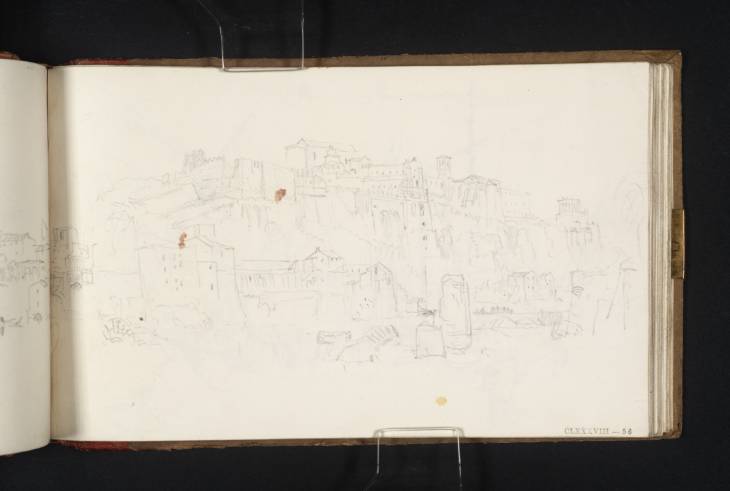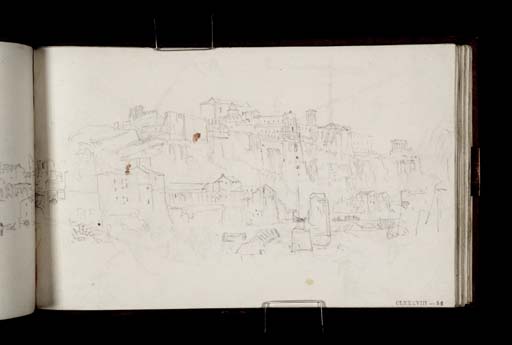Joseph Mallord William Turner Aventine Hill from the River Tiber, Rome 1819
Image 1 of 2
Joseph Mallord William Turner,
Aventine Hill from the River Tiber, Rome
1819
Joseph Mallord William Turner 1775–1851
Folio 54 Recto:
Aventine Hill from the River Tiber, Rome 1819
D16257
Turner Bequest CLXXXVIII 56
Turner Bequest CLXXXVIII 56
Pencil and watercolour on white wove paper, 114 x 189 mm
Stamped in black ‘CLXXXVIII 56’ bottom right
Accepted by the nation as part of the Turner Bequest 1856
References
1909
A.J. Finberg, A Complete Inventory of the Drawings of the Turner Bequest, London 1909, vol.I, p.560, as ‘Banks of Tiber’.
The main sketch depicts the eastern bank of the River Tiber looking downstream towards the Aventine Hill, in the opposite direction from folio 53 (D16249; Turner Bequest CLXXXVIII 52). Turner’s viewpoint is near the Porto di Ripa Grande on the opposite side, the same location as the sketch on folio 54 verso (D16258; Turner Bequest CLXXXVIII 56a). The buildings along the level of the river include some of the mills and storehouses which characterised this part of the city. On the higher ground above can be seen (from left to right) the basilica of Santa Sabina with the rounded apse, the Romanesque bell-tower of Sant’Alessio all’Aventino (today known as Santi Boniface e Alessio) and the shorter, squarer tower of Santa Maria del Priorato, the Church of the Knights of Malta. As a young man Turner made a ‘Monro School’ copy drawing of a similar view, probably after John Robert Cozens, Rome: The Tiber with the Aventine on the Left c.1794–7 (National Gallery of Scotland).1
On the far left-hand side is a separate drawing, a continuation of the view on the opposite sheet of the double-page spread, see folio 53 verso (D16250; Turner Bequest CLXXXVIII 52a). This depicts part of the view on the eastern bank of the River Tiber near the Ponte Rotto and includes the unusual ruins of the medieval Casa dei Crescenzi, a former tower fortress converted into a mansion during the eleventh century by the powerful Crescenzi family using fragments of Roman remains. The house, which stands near the Ponte Rotto on the present-day Via Luigi Petroselli, is also known as the Cola di Rienzo, or the Casa di Pilato (House of Pilate). This last name refers to the tradition of performing Passion plays within the city from the fifteenth century onwards. Certain streets were thought to resemble the Via Dolorosa in Jerusalem and the Casa dei Crescenzi became the stand-in for the House of Pontius Pilate where the scenes of Christ’s flagellation, the crown of thorns and the Ecce Homo took place.2 For a detailed sketch of the building see the Albano, Nemi, Rome sketchbook (Tate D15362; Turner Bequest CLXXXII 36).
At some point in the past, this page was bound within a different location within the sketchbook, as reflected by the Turner Bequest (Finberg) numbering. However, the relationship with folio 53 verso was established owing to matching the continuation of the view of the Tiber, and also by the dot of yellow watercolour at the bottom, transferred from the opposite sheet when the book was closed upon the wet pigment.
Nicola Moorby
September 2008
How to cite
Nicola Moorby, ‘Aventine Hill from the River Tiber, Rome 1819 by Joseph Mallord William Turner’, catalogue entry, September 2008, in David Blayney Brown (ed.), J.M.W. Turner: Sketchbooks, Drawings and Watercolours, Tate Research Publication, December 2012, https://www


